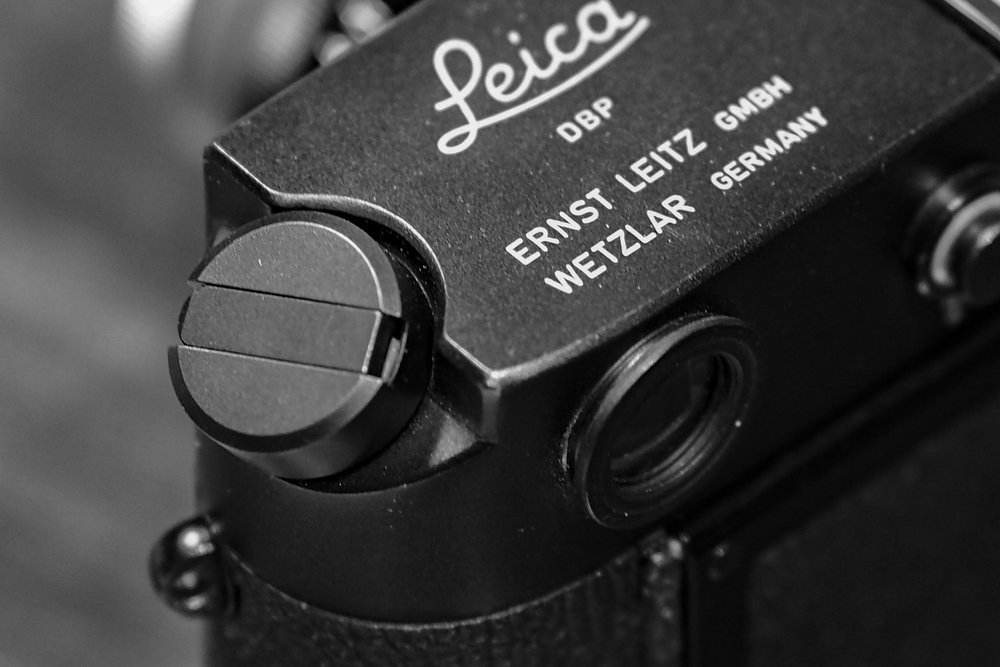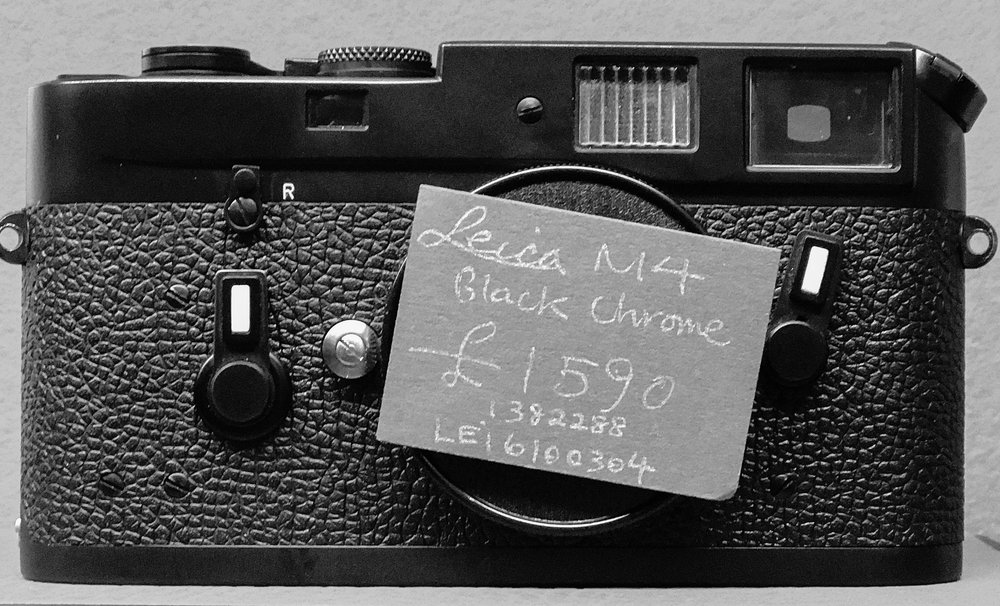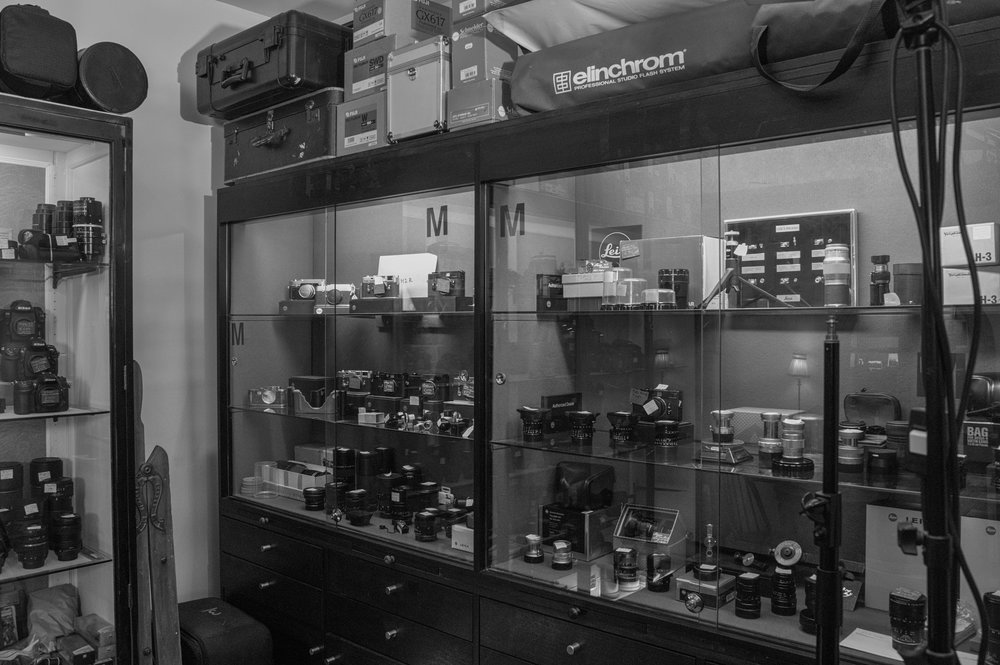
A few days ago I was asked by Amateur Photographer’s assistant editor, Geoff Harris, for background on the Leica M4 in connection with an M4 50th anniversary article he was putting together for a up-market yachting magazine.
Funny he should ask that. While I have a good general knowledge of the Leica story, from Barnack to Q, the M4 saga has always been difficult to follow. It’s not only the three main models, M4, M4-2 and M4-P, it’s the split manufacture between Wetzlar and Midland, Ontario, not to mention the brief sabbatical while the portly but advanced M5 rose and fell. It’s quite a story.
Adding to confusion is that secondhand prices are all over the place, everything depending on which model is in focus and, above all, on the finish of the body. Canadian M4-x cameras were predominantly produced in black chrome, so the few silver chrome relicts command a small premium. Conversely, Wetzlar M4s were largely in silver chrome with the result that black is normally more expensive. That’s black chrome. The even rarer black-paint M4 is top of the tree.
Production
M4 production topped out at about 58,000 examples compared with the 225,000 run of the earlier M3 — another factor in adding to rarity value. Of the total of M4s just 6,775 were finished in black chrome and 4,889 in black paint. As always, limited production sets the collectors’ pulses racing.

The M4 is considered by many to be the finest of the unmetered Ms. Some prefer the M3 or, even, the M2, but the M4 combined the best of its predecessors’ virtues, including superb build quality, and added a feature or two. With its engraved top-plate and M3-like craftsmanship, the M4 upped the rangefinder game. Its additional features, which don’t sound too impressive at this remove, were actually a big deal at the launch in November 1966.

The angled rewind lever, instead of the knob on earlier models was, in its way, as big an improvement as the film advance lever on the first M3. It dramatically speeded up the rewind process. And the quick film loading feature, dispensing for the fist time with a return spool, was a hit. The new advance lever with its floating end-piece received a mixed reception but few could argue with the benefit of the self-setting film counter.
Above all, the M4 in 1966 continued the tradition of the M3. With framelines for 35, 50, 90 and 135mm lenses it was also more practical than the M3 which lacked the 35mm lines, necessitating an external finder.
Clouds on the horizon
But clouds were gathering on the horizon even as the M4 was launched. Rangefinders were losing ground to SLRs and Leica had failed to offer serious competition in that area. The company was also encountering financial problems — its rangefinders, typified by the M4, were hand-made by craftsmen and expensive to produce. The situation was exacerbated by the failure of the radical M5 — the first M with an exposure meter. M4 production was stopped briefly in 1972 but the poor reception of the M5 caused Leica to restart the M4 and, soon, to move production to the E.Leitz Canada plant in Midland, Ontario. Some 2,500 M4s were made in Canada towards the end of the run.

The solution to Leica’s problems came in the form of a new, simpler production process and trimmed features to keep costs down. In particular, instead of the painstaking adjustments and artisanal tinkering that typified earlier cameras, the plan was to introduce a standardised component system. Less adjustment was possible and, if something didn’t quite work or was out of tolerance it was simply swapped. Previously, the craftsman would have performed custom adjustments to individual parts.
Plain Jane Leica
The ensuing 1977 M4-2, often called the “plain Jane Leica”, was the camera that saved Leitz. It compromised in several ways beyond the cheaper production system. It had a stamped top plate in preference to the M4’s engraved plate; the rangefinder optics were cheapened by the removal of a condenser and the self-timer was deleted. It did, however, grow some new features — the ability to attach a motor drive and the addition of a hotshoe.
Early production difficulties led to some questions over reliability but these were tackled and the M4-2 remains a popular buy, even if prices are lower than the M4 and the subsequent M4-P. One internet dealer in second-hand cameras, Peter Loy, told me that the M4-2 can sometimes be troublesome. But Patrick Tang at Aperture Photographic isn’t so sure. He hasn’t noticed particular problems with the M4-2 and, he says, if he has an M4, M4-2 and M4-P on display it is the M4-2 that will sell first. It makes an great “budget” buy and should perform flawlessly.
The M4-P was the last of the rather complex M4 range. Introduced in 1981, it was identical to the M4-2 but with the addition of 28 and 75mm framelines. It is generally considered to be more reliable than the M4-2 and commands a slightly higher resale value. Interestingly, the last thousand M4-Ps were made back in Wetzlar (serial numbers 1691951-1692950 in case you have one under the bed).
When considering buying a used M4/2/P there are lots of factors, including specification, location of manufacture and colour to take into account. As I mentioned earlier, the rarer the colour finish the more the cost.

If asked for a recommendation I would say that the sweet spot is either a pre-1977 M4 in silver chrome or an M4-P in black chrome. You’ll pay more for a black chrome M4 or a silver chrome M4-P so, unless you are a collector and are prepared to pay the premium — or really must have the rarer model for aesthetic reasons — the more popular colour is the one to go for.
Between these two cameras you might be swayed by the fact that the later M4-P has the comprehensive 28/35/50/75/90/135 viewfinder lines to cope with the majority of M lenses. It is also able to handle a motor drive like the M4-2 but unlike the M4. This, however, is less important these days than it was when the camera was in use for professional purposes. Personally, I find the motor drive pretty pointless. I have one (for use on my MP, not the M4) but soon got fed up. With only 36 shots on hand, it’s more satisfying to use the advance lever.
Revived fortunes
In the past couple of years there has been a revival in the fortunes of all Leica film cameras (perhaps with the exception of the M5 and M7, although both these cameras have their dedicated fans). Young people are rediscovering film — as is Kodak by all accounts — and the Leica M3 is the camera that grabs most attention. The M6, also, as the first traditional M to incorporate an exposure meter (the quirky and short-lived M5 led the way, but that’s another story) is high on the wish list. The M4 is somewhere in the middle.
I have acquired samples of all M film camera ranges except the M5 (but I’m not a collector, you understand) and, given the choice, I’d pick my German-made black chrome M4 model as the most handsome and enjoyable to use — the pick of the bunch. I bought it from Aperture Photographic in Rathbone Place, London (see link below). It isn’t for nothing that the M4 is considered to be the finest unmetered M model you can buy.

The black-chrome M4 is also the definite favourite of noted Leica expert and Macfilos contributor Frank Dabba Smith, albeit in his case the rarer Canadian version engraved ‘Midland’. For so many of us, a much loved camera model also depends on our personal histories as Frank relates:
“In 1975, I was in my first year studying at University of California at Berkeley and I was getting more and more involved with photography and became especially interested in photojournalism.
“Two friends at Berkeley had black chrome Midland M4s and I was seduced by the functionality and appearance of this camera. Unlike other people, I was especially drawn to the flat black finish and the white infills on the frame selector and self-timer levers. I’ve owned every M variant along the way but the Midland M4 is my quintessential Leica.” Today, Frank still uses his Midland M4 along with an M-A when he works with film.
Dealer versus auction site
If you fancy an M4 bear in mind that, because of the smaller production run, secondhand examples are rarer than, say, the prolific M3. I would always recommend buying from a dealer rather than an auction site. No doubt you can get bargains from eBay or similar, but this is by no means guaranteed. You might end up paying more than you would at a reputable dealer who will always provide a level of after sales service and, in some cases, a limited warranty.
One point worth noting is that most, if not all, Leica rangefinders of whatever age will likely hold their value and could well appreciate in nominal value because of inflation. So, in general, your running costs will be minimal because there is no depreciation to take into account. You could even sell at a profit in a few years’ time when you want to upgrade.

A good dealer will give you an honest assessment of the condition of the camera, including whether or not it has been recently serviced. In some cases he might recommend a “CLA” (clean, lubricate, adjust) and that can cost around £160. It’s worth doing if there is any question over shutter speeds, for instance. They can get out of adjustment, often from lack of use (I have a regular schedule reminder to “exercise” my film cameras), and it’s a point to check when buying.
How much to pay? I consulted two experienced dealers, Peter Loy and Will Tang at Aperture Photographic. These are ballpark figures and, as usual, exceptional condition and provenance (box, papers, original receipt, famous but careless owner) can command a premium. Prices have risen in recent months following the fall in the value of the pound sterling, mainly because foreign buyers have snapped up existing stock which looked cheap to them.
- M4, silver chrome – £700-£1,000
- M4, black chrome – £1,200-£2,000
- M4, black paint – £2,200-£3,000
- M4-2, black chrome – £500-£700 (slight premium for silver chrome)
- M4-P, black chrome – £600-£900 (ditto)
Recommended dealers:
I can personally recommend the following dealers for both for personal visits and internet browsing. Please mention Macfilos if you’ve enjoyed this article.
- Red Dot Cameras (showroom)
- Aperture Photographic (showroom)
- Richard Caplan (showroom)
- Peter Loy (internet)
- MW Classic Cameras (internet)
- Leica Store Manchester (showroom)
_____________
- Subscribe to Macfilos for free updates on articles as they are published. Read more here
- Want to make a comment on this article but having problems? Please read this

Since this article was published prices have more than doubled!
M4 £1600
M4-P £1650
Black chrome and black paint – telephone numbers!!
Richard Caplan sadly closed now.
Red Dot highly recommended!
I think all M-mount film cameras have rocketed in price, with the M6 tending to be the most popular mainstream choice. The model I don’t hear too much about is the M7 and I must check to see how the prices are doing. The MP and M-A, which sell new in the UK for £4,100 are in such short supply that some used examples are fetching prices in the mid £3k range. A couple of years ago you could pick up an early MP for around £2,000, but you are now looking at around £3,000. Yes, Red Dot is a good place to look for new and used Leica film cameras.
Wow – timing of this article is spooky – just began looking at M4s to rectify my foolish mistake of selling my M2 late last year. No offense to my G2 kit but I just need a black paint M4.
Thanks for the great information, particularly in regards to the ballpark figures for each variants. Any thoughts on repainted cameras? There is a nice on on Red Dot at the moment for £1,200 – is this about right for a good repaint?
Aaron,
I’ve checked this out for you. It’s in lovely condition and Ivor at Red Dot says it is really nice. The guy who sold it to him had paid £1,600 to have it painted black, so at £1,200 I think it is more than good value. It wouldn’t fetch as much as a genuine black-chrome, nor, of course, an original black paint (even in shit order) but I think you would have yourself a very nice camera for relatively little money. Go for it!
Wow the gear lust is real! Ironically I bought my original M2 from Red Dot in the first place!
Wonder how fast I could sell my G2 Millennium Kit…
Thanks so much for looking into this for me!
I still prefer the M5
My film body of choice has long been the M5. It is the last Leica with traditional build and the better rangefinder, it has by far the best meter (true spot meter) and is the smoothest and fastest for me in use thanks to its shutter speed display in the finder, overhanging shutter speed dial and match needle metering without distracting LEDs.
Sadly, M5s have caught on and they are no longer the secret cheap entry into Leica land.
Andrew, I’m glad you brought his up. I know we’ve discussed it before and I am aware of your liking for the M5 (indeed, I had you in mind when I made the comment in the article). I also think the M5 has been misjudged, although personally I don’t much like the look of it. But it’s something to consider although, as you say, prices are no longer cheap.
Always an education, article and comments, thank you!
I have all of the film Ms from the M3 through to the M7 apart from the M6TTL. I have the 3 M4 varieties and they are all very good cameras. People should not be put off by the ‘bar room bore’ and ‘old wives tale’ stuff. The M4-2 and the M4-P are at least as good construction-wise as today’s M240 or M10. Yes there were some elements left out of the rangefinder somewhere along the line which continued into the M6, but I have never had real problems with patch flaring or whiteout with any of these cameras. Yes, the earlier viewfinders were magnificent (perhaps even over-engineered), but later ones are very good and on a day’s shooting I doubt if anyone would notice a real difference.
I have the M4-2 winder (works on my M4-2 and my M4-P) which is large and clunky but not an unusable ‘bucking bronco’ as I had been led to believe. This was, of course, an attempt to keep up with the SLR crowd, but I am with Mike on this. M Leicas are intended to be small, discrete and easy to carry cameras and they work best on their own with a wide to standard Leica prime, 35mm or 50mm.
Some people don’t like the M4-P framelines as they say that the inclusion of 28mm framelines makes things a bit cluttered. Certainly for glasses wearers ( I never take them off when using any camera) such as myself the framelines are on the fringes and I have to move my eye around when using them. A separate viewfinder is probably to be recommended for glasses wearers when using a 28mm lens on the M4-P or the M6.
I prefer cameras not to have a self timer lever on the right hand side. I find the rewind lever (marked R) uncomfortable under my hand (particularly on the M5) but it is easier to find a comfortable position for my right hand when there is no self timer lever. One of my favourite cameras in the M line, so far as my right hand is concerned, is my button rewind M2 with no self-timer lever.
My favourite film M is the M3 because of the wonderful viewfinder, probably followed by the M2 and then the M4. I also like the M6 as it seems light and small and has metering. The M4-2 and M4-P come next. The film Ms I like least are the M7 and M5. Yes, they have metering but they are not as nice to handle as the others. The M5 definitely leaves me with sore hands after a day’s shooting. Those with larger hands may not agree.
A lot of this is about personal preference as handling issues can vary from one photographer to another. One thing is probably true, though. The M4-2 is often referred to as ‘the camera that saved Leica’. Without it, you probably would not have your M240, M-D or M10 to play around with today.
William
I think you just proved that there is no such thing as "the best" Leica rangefinder. All have their differing specifications and foibles. It’s good that we have such a wide range of options when choosing Leica film camera. As you know from your own experience, even pre-M cameras with their twin view/range windows have many fans. The IIIg, which was produced alongside the M3 for some six years is still a great camera and, I would argue, one of the most handsome of the lot. The good thing, which needs repeating, is that (lens for lens) all will take exactly the same photographs. This is the big difference between film and digital with its built-in obsolescence.
The same criteria apply with LTM models. Yes, the IIIg is a very nice camera with a much improved viewfinder. From a handling perspective, my favourite user LTM is a IIf Red Dial which has no slow speed dial or self timer (I use neither), the absence of which aids my right hand preferences. It is also smaller than the IIIg but has the ‘improved shutter’.
From a collector perspective, my favourite Leica cameras would include anything made between 1925 and 1935. The vast majority of those are black with nickel ‘furniture’. I have nothing against silver chrome, though. My 240 is silver chrome, as will be my M10, whenever that might arrive.
William
I am not a particularly skilful photographer, but I enjoy myself and unlike the people that you mention here Mike, I have relatively little experience with good cameras…
I would contend that the capture of keepers is more likely from a camera with aperture priority, so for me and film, my next target is likely to be an M7, as I notice that I am far more at home with my M-P than any previous Leica… I am keen to learn more about film development.
There is nothing worse than getting a great composition ruined through misjudgement of the light, the AP is a good safety mechanism for avoiding such things.
So for me, the M4 is for the collectors amongst us… And of course the old timers who consistently nail their exposures.
I believe that Irwin Puts has a similar contention.
Stephen,
As you know, I dabble in film but since most of my photography is intended for use on this site (and is often topical, requiring a quick turnround) I rely mainly on digital. Film is a fad for me and I do like the M cameras (and their LTM predecessors) as objets d’art to have around the house and office. The fact that they all work is an added bonus. You are right that the M7, which is an underrated camera and unfairly criticised by some, is the only choice if you want to mirror modern aperture-priority shooting. It is easier but then the accuracy of metered M6 and MP models is just as good, just a bit more fiddling. The M7 is quicker, of course, and you can forget you are using film because it is so like an M digital to use. This impression will be even more pronounced once we become used to the size and heft of the new M10. I know Irwin has a soft spot for the M7 and I think it makes a great choice for anyone who wants to take up film seriously. It’s also a bargain because it depreciates more rapidly that other current models (MP, M-A). You can pick up an excellent M7 for around £1,200 compared with, for instance, £2,000-£2200 for the MP which is more desirable to collectors. I doubt the M7 will depreciate significantly from its £1,200 base and, if fashions change, is the most likely to go up in value.